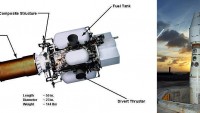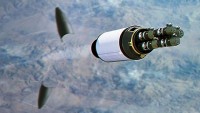Destruction of ICBM Ensures US Domination of the World, says China
| Arthur Dominic Villasanta | | Jun 04, 2017 08:39 AM EDT |
(Photo : US Army) GBI mounting an EKV.
The successful interception of an intercontinental ballistic missile (ICBM) target by a kill vehicle last May 30 ensures the United States' domination of the world, said an interesting analysis appearing in the website of the People's Liberation Army (PLA).
The U.S. success might also motivate India to accelerate work on perfecting its decade-old Ballistic Missile Defense Program to counter ballistic missile attacks from China.
Like Us on Facebook
This ICBM interception "indicated progress in America's strategic defense technology, but it's not good news for maintaining the current strategic balance among major powers in the world," said the author, Senior Colonel Wang Mingzhi, a professor at the Air Force Command College of the People's Liberation Army Air Force (PLAAF).
Col. Wang noted the current strategic balance among the contending world powers (the U.S. versus China and Russia) "is largely based on the capability of Mutually Assured Destruction (MAD) of the second nuclear attack, which is effective in preventing nuclear war and ensuring strategic stability."
First applied during the late 1940s in the Cold War, MAD is a doctrine of military strategy and national security policy in which a full-scale use of nuclear weapons by two or more opposing sides will cause the complete annihilation of both the attacker and the defender.
It is based on the theory of deterrence, which holds the threat of using nuclear weapons against an enemy prevents the enemy's use of those same weapons. The development of a missile defense system by one side will violate the MAD doctrine and destabilize the situation, because the side that does so won't have to fear the consequences of a second strike by its enemy.
This is the situation China (and Russia) see themselves as being trapped in, hence their furious opposition to THAAD, Patriot and the Ground-Based Midcourse Defense (GMD) that was used in the May 30 intercept.
GMD is the United States' anti-ballistic missile system for intercepting incoming warheads in space, during the midcourse phase of ballistic trajectory flight.
Col. Wang argued the "enhancement of America's missile defense capability will, in theory, undermine the effectiveness efficacy of nuclear strikes launched by its main strategic rivals (Russia and China), thus consolidating its own domination."
This state of affairs will also goad other countries into developing their own "strategic penetration technology at a faster pace or enhance their own strategic defense capability, which will exert a new impact on international security," an obvious reference to India.
The Indian Ballistic Missile Defense Program seeks to develop and deploy a multi-layered ballistic missile defense system to protect India from ballistic missile attacks by Pakistan and China.
It consists of two land and sea-based interceptor missiles: the Prithvi Air Defense (PAD) missile for high altitude interception, and the Advanced Air Defense (AAD) Missile for lower altitude interception. The two-tiered shield should be able to intercept any incoming missile launched from 5,000 kilometers away.
Despite being developed over the past 10 years, the program is not yet fully operational.
On May 30, an "ICBM-class target" fired toward the U. S. mainland from Kwajalein Atoll in the Marshall Islands was destroyed over the Pacific Ocean by an "Exoatmospheric Kill Vehicle" (EKV) in a test meant to demonstrate the effectiveness of U.S. anti-ballistic missile defenses.
The target fired from the Ronald Reagan Ballistic Missile Defense Test Site on Kwajalein Atoll in the Marshall Islands, 6,600 km from the mainland was "successfully intercepted" at 3:30 p.m. ET by a Ground-Based Interceptor (GBI) launched from Vandenberg Air Force Base in California.
Tagsintercontinental ballistic missile, kill vehicle, United States, People's Liberation Army, Ballistic Missile Defense Program, India, Senior Colonel Wang Mingzhi, Mutually Assured Destruction, Mad, Prithvi Air Defense (PAD) missile
©2015 Chinatopix All rights reserved. Do not reproduce without permission
EDITOR'S PICKS
-

Did the Trump administration just announce plans for a trade war with ‘hostile’ China and Russia?
-

US Senate passes Taiwan travel bill slammed by China
-

As Yan Sihong’s family grieves, here are other Chinese students who went missing abroad. Some have never been found
-

Beijing blasts Western critics who ‘smear China’ with the term sharp power
-

China Envoy Seeks to Defuse Tensions With U.S. as a Trade War Brews
-

Singapore's Deputy PM Provides Bitcoin Vote of Confidence Amid China's Blanket Bans
-

China warns investors over risks in overseas virtual currency trading
-

Chinese government most trustworthy: survey
-

Kashima Antlers On Course For Back-To-Back Titles
MOST POPULAR
LATEST NEWS
Zhou Yongkang: China's Former Security Chief Sentenced to Life in Prison

China's former Chief of the Ministry of Public Security, Zhou Yongkang, has been given a life sentence after he was found guilty of abusing his office, bribery and deliberately ... Full Article
TRENDING STORY

China Pork Prices Expected to Stabilize As The Supplies Recover

Elephone P9000 Smartphone is now on Sale on Amazon India

There's a Big Chance Cliffhangers Won't Still Be Resolved When Grey's Anatomy Season 13 Returns

Supreme Court Ruled on Samsung vs Apple Dispute for Patent Infringement

Microsoft Surface Pro 5 Rumors and Release Date: What is the Latest?













